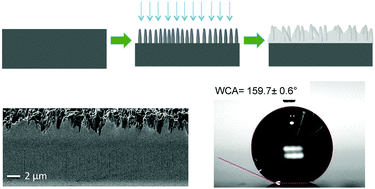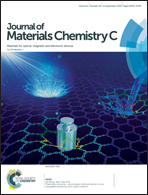Self-cleaning, high transmission, near unity haze OTS/silica nanostructured glass†
Abstract
High haze, high transparency substrates can increase the power conversion and extraction efficiency of solar cells and light emitting diodes (LEDs), respectively. In this paper, we demonstrate a new octadecyltrichlorosilane (OTS)/silica nanostructured substrate that displays high transmission (91.5 ± 0.5% at 550 nm wavelength) and near unity haze (98.1 ± 0.5% at the same wavelength) with 143° scattering angle. The OTS/silica nanostructures are fabricated through a scalable and facile maskless reactive ion etching (MRIE) process followed by OTS coating. The OTS coating enhances the transmission of the structures by merging silica nanostructures together by capillary forces and effectively grading the index of refraction. The OTS/silica nanostructures display the highest combination of both transmission and haze in the literature as defined by Pareto optimality. The OTS/silica nanostructured glass exhibits lotus leaf-like wetting with a 159.7 ± 0.6° water contact angle (WCA) and 4.9 ± 0.6° contact angle hysteresis. We demonstrate the structures have self-cleaning functionality where about 100% of transparency can be easily recovered after graphite soiled substrates are rinsed with water. This self-cleaning functionality is maintained after 200 cycles of soiling and cleaning. The OTS/silica nanostructured glass may be an important substrate in optoelectronic applications where a combination of high transmission, high haze, and self cleaning function are important.



 Please wait while we load your content...
Please wait while we load your content...